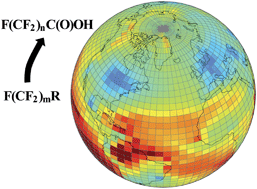当前位置:
X-MOL 学术
›
Environ. Sci.: Processes Impacts
›
论文详情
Our official English website, www.x-mol.net, welcomes your
feedback! (Note: you will need to create a separate account there.)
A global atmospheric chemistry model for the fate and transport of PFCAs and their precursors.
Environmental Science: Processes & Impacts ( IF 4.3 ) Pub Date : 2020-01-16 , DOI: 10.1039/c9em00326f Colin P Thackray 1 , Noelle E Selin 1 , Cora J Young 2
Environmental Science: Processes & Impacts ( IF 4.3 ) Pub Date : 2020-01-16 , DOI: 10.1039/c9em00326f Colin P Thackray 1 , Noelle E Selin 1 , Cora J Young 2
Affiliation

|
Perfluorocarboxylic acids (PFCAs) are environmental contaminants that are highly persistent, and many are bio-accumulative and have been detected along with their atmospheric precursors far from emission sources. The overall importance of precursor emissions as an indirect source of PFCAs to the environment is uncertain. Previous studies have estimated the atmospheric source of PFCAs using models and degradation pathways of differing complexities, leading to quantitatively different results. We present results from simulations of atmospheric PFCA formation and fate using the chemical transport model GEOS-Chem. We simulate the most up-to-date chemistry available to our knowledge for the degradation of the precursors fluorotelomer alcohol (FTOH), fluorotelomer olefin (FTO), and fluorotelomer iodide (FTI), as well as the deposition and transport of the precursors, intermediates and end-products of the formation chemistry. We calculate yields of C3-C13 PFCAs formed from 4 : 2 to 12 : 2 fluorotelomer precursors and their deposition to the surface. We find that the ratio of long-chain to short-chain PFCAs increases strongly with distance from source regions. We compare our model results to remote deposition measurements and mid-latitude rainwater measurements. The model captures the observed relationship between rainwater abundance and PFCA chain length, as well as the average deposition rates at mid-latitude and Arctic sites, but underestimates the deposition of PFDoA, PFDA, and TFA at mid-latitudes and PFNA at the Devon Ice Cap. We provide estimates of cumulative PFCA deposition globally. We find that given the most recent emission inventory, the atmospheric source of PFCAs is 6-185 tonnes per year globally and 0.1-2.1 tonnes per year to the Arctic.
中文翻译:

PFCA 及其前体的归宿和迁移的全球大气化学模型。
全氟羧酸 (PFCA) 是一种高度持久性的环境污染物,许多具有生物累积性,并且在远离排放源的大气中前体物中被检测到。作为全氟辛烷磺酸的间接来源,前体排放对环境的总体重要性尚不确定。先前的研究使用不同复杂性的模型和降解途径估算了 PFCA 的大气来源,导致了定量上不同的结果。我们展示了使用化学迁移模型 GEOS-Chem 模拟大气 PFCA 形成和归宿的结果。我们模拟了据我们所知的最新化学方法,用于前体含氟调聚物醇 (FTOH)、含氟调聚物烯烃 (FTO) 和含氟调聚物碘化物 (FTI) 的降解,以及前体的沉积和传输,形成化学的中间体和最终产物。我们计算了由 4:2 至 12:2 含氟调聚物前体形成的 C3-C13 PFCA 的产率及其在表面的沉积。我们发现,长链和短链 PFCA 的比例随着距源区的距离的增加而急剧增加。我们将模型结果与远程沉积测量和中纬度雨水测量进行比较。该模型捕捉了观测到的雨水丰度与 PFCA 链长度之间的关系,以及中纬度和北极地区的平均沉积率,但低估了中纬度地区 PFDoA、PFDA 和 TFA 以及德文郡冰区 PFNA 的沉积量帽。我们提供全球 PFCA 累积沉积的估计值。我们发现,根据最新的排放清单,全球 PFCA 的大气来源为每年 6-185 吨,北极每年为 0.1-2.1 吨。
更新日期:2020-02-26
中文翻译:

PFCA 及其前体的归宿和迁移的全球大气化学模型。
全氟羧酸 (PFCA) 是一种高度持久性的环境污染物,许多具有生物累积性,并且在远离排放源的大气中前体物中被检测到。作为全氟辛烷磺酸的间接来源,前体排放对环境的总体重要性尚不确定。先前的研究使用不同复杂性的模型和降解途径估算了 PFCA 的大气来源,导致了定量上不同的结果。我们展示了使用化学迁移模型 GEOS-Chem 模拟大气 PFCA 形成和归宿的结果。我们模拟了据我们所知的最新化学方法,用于前体含氟调聚物醇 (FTOH)、含氟调聚物烯烃 (FTO) 和含氟调聚物碘化物 (FTI) 的降解,以及前体的沉积和传输,形成化学的中间体和最终产物。我们计算了由 4:2 至 12:2 含氟调聚物前体形成的 C3-C13 PFCA 的产率及其在表面的沉积。我们发现,长链和短链 PFCA 的比例随着距源区的距离的增加而急剧增加。我们将模型结果与远程沉积测量和中纬度雨水测量进行比较。该模型捕捉了观测到的雨水丰度与 PFCA 链长度之间的关系,以及中纬度和北极地区的平均沉积率,但低估了中纬度地区 PFDoA、PFDA 和 TFA 以及德文郡冰区 PFNA 的沉积量帽。我们提供全球 PFCA 累积沉积的估计值。我们发现,根据最新的排放清单,全球 PFCA 的大气来源为每年 6-185 吨,北极每年为 0.1-2.1 吨。











































 京公网安备 11010802027423号
京公网安备 11010802027423号